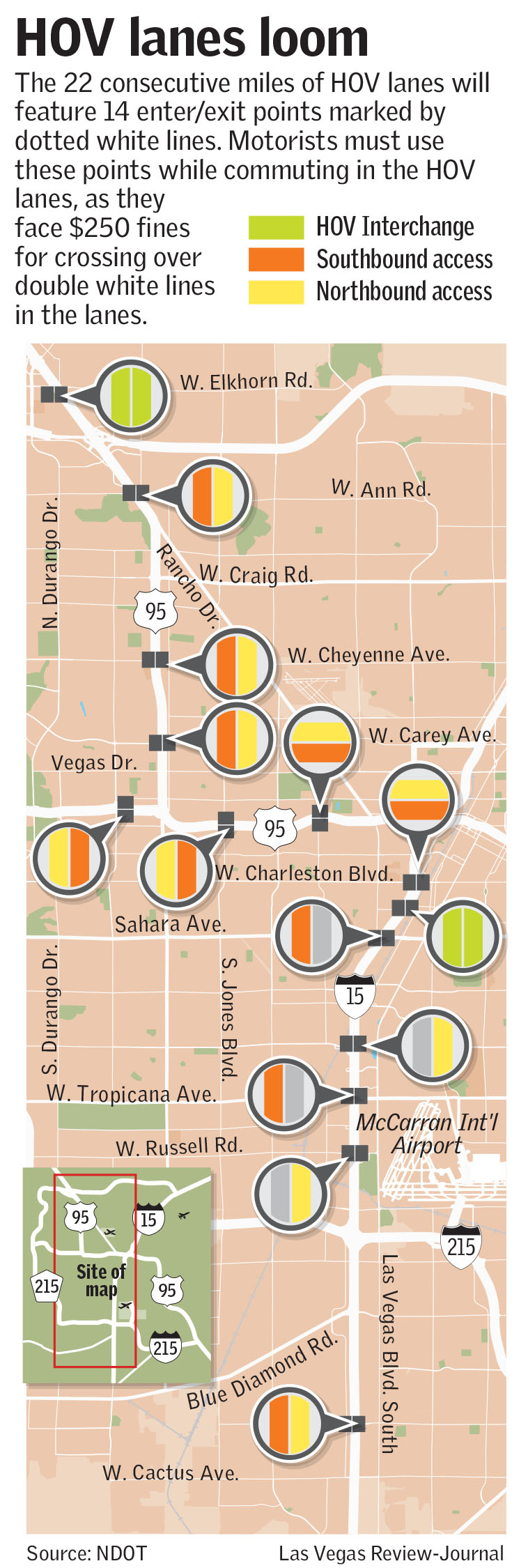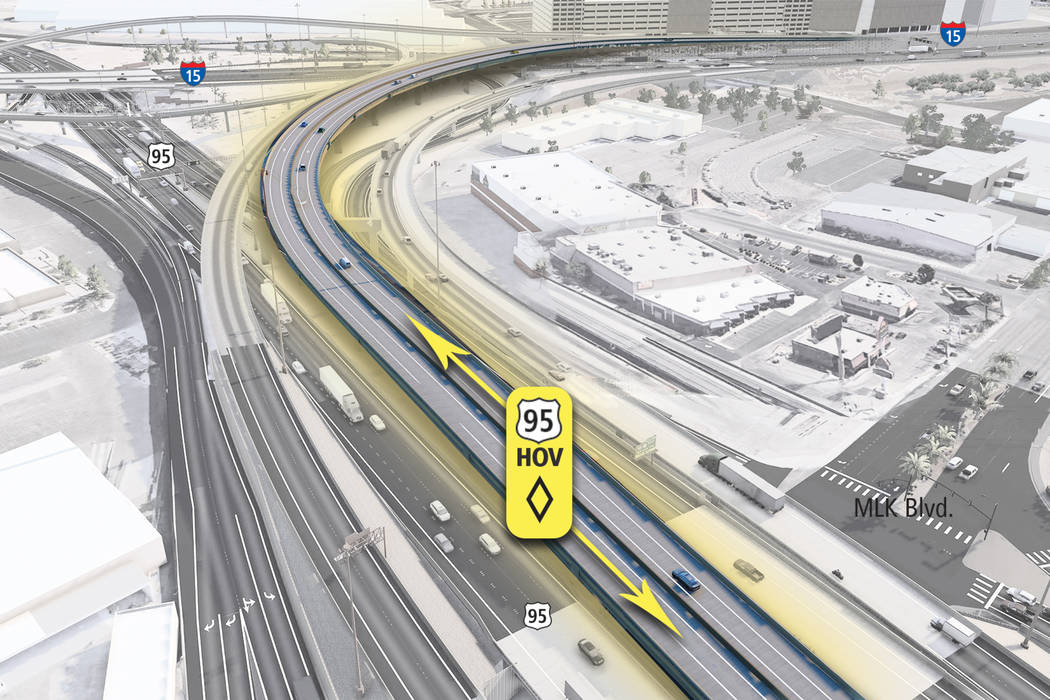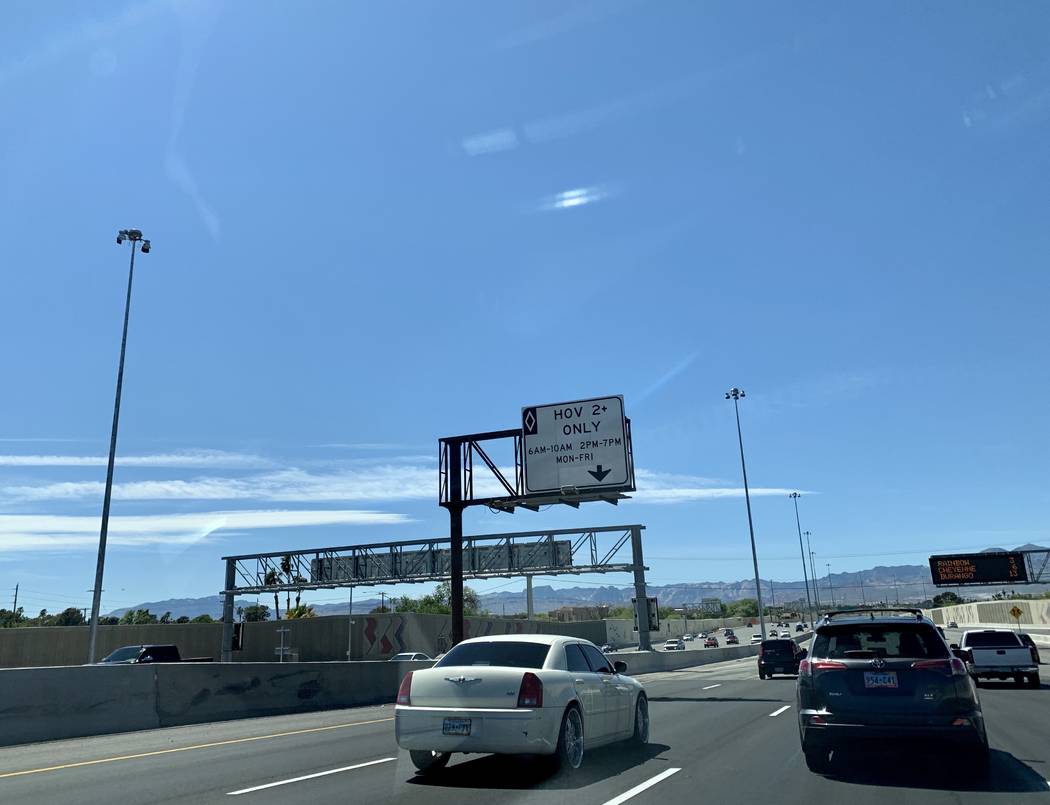Las Vegas officials concerned about HOV lane regulations
Las Vegas city officials want to put the brakes on portions of proposed changes in the rules governing high occupancy vehicle lanes that are slated to take effect when Project Neon is completed next month.
The new laws will govern what will be 22 consecutive miles of HOV lanes stretching from Silverado Ranch Parkway on Interstate 15 in the south valley to Elkhorn Drive on U.S. Highway 95 in the northwest valley. The current express lanes will be converted to one HOV lane and one general purpose lane; HOV lanes already exist on U.S. 95 from just after the Spaghetti Bowl to Elkhorn Road.
On Wednesday, Dale Keller, Nevada Department of Transportation’s assistant chief of project management, gave the Las Vegas City Council an overview of the coming HOV lane changes. After the briefing, Councilman Stavros Anthony said if it were up to him there would be no carpool lanes.
“I want to drive in those lanes, too,” Anthony said. “But I don’t because I’m not going to violate the law.”
Anthony said he regularly speaks with residents in his area of the northwest valley, where the current HOV lanes run, and they aren’t happy about the existing HOV lanes, even with the current intermittent regulations.
“They’re ticked off that they can’t use these lanes,” he said. “When there’s traffic they don’t want to violate the law, but some of them drive in them anyway.”
New regulations
Under the new regulations, motorists allowed to travel in the HOV lanes include: vehicles with two or more occupants (babies count as passengers, but pets don’t); motorcycles, even with one rider; RTC buses, with or without passengers; and emergency vehicles, with lights on or off.
Not allowed in the carpool lanes are: vehicles with one occupant; electric cars, unless with two occupants, as per Nevada law; and tractor-trailer trucks with two or more axles, even with two occupants.
The times that the HOV lanes are regulated also will change.
Currently the HOV lanes are utilized as such only during high traffic times, from 6 to 10 a.m. and 2 to 7 p.m. Monday through Friday. Under the new rules, the HOV lanes will be enforced 24 hours per day, 7 days per week.
Additionally, crossing the solid double white line of an HOV lane is also illegal; motorists are allowed to enter and exit the lane only where dotted lines are present. There will be 14 enter/exit points across the 22 miles of HOV lanes where motorists can legally move in and out of the lanes.

Motorists will face a $250 fine for violating any of the prohibited actions in the carpool lanes.
The lack of current regulation on the existing HOV lanes worries Anthony, and said adding the 24-hour restriction will create even more issues.
Despite Anthony’s concerns, Highway Patrol Trooper Lt. Chris Dreyer said the uniform rules will actually help the department enforce them, despite the increased hours.
“The changes that will be made in regards to 24/7 help us with enforcement,” Dreyer said. “(Today) we don’t do a lot of active enforcement because we don’t have the people to do it. Some of the traffic accidents we’ve seen could have been prevented with a smoother flow of traffic, and I think that is the goal of the HOV lanes.”
Round-the-clock enforcement
Councilwoman Michele Fiore doubled-down on the 24-hour regulation concern.
“That’s something that we really have to look at,” Fiore said. “You’re looking at taking the benefit of everyone else using the HOV lanes at certain hours and making it 24/7, and I am in 100 percent disagreement with that, at minimum.”
The time HOV lanes are enforced is at the discretion of each individual state and department of transportation, according to Keller.
Councilman Bob Coffin said he was in support of the HOV lanes, due to the perceived environmental effect the lanes could have on reducing emissions as residents carpool with each other.
He didn’t understand why electric or hybrid vehicles wouldn’t be allowed to travel in them even when those vehicles have one occupant, as is the case in California and other states.
“I know environmental was a big reason for the HOV lanes,” Coffin said. “Congestion creates pollution, and this was a move to decrease congestion. … Environmental reasons include allowing hybrid or electric cars to be using these lanes, too, because they don’t produce pollution. I bet you we can revise this at some time in the future to include electric and hybrid vehicles.”
Keller said NDOT will monitor the HOV lanes when they open and the department will make changes to any aspect it feels is needed. Keller also said there’s federal funding tied in with the valley’s freeway system, with HOV lanes being part of that.
Despite the funding tied to the HOV lanes, Anthony requested the HOV changes be discussed again at the May 15 City Council meeting, with a public comment period open between now and the meeting.
The city will post HOV-related questions on the city’s Nextdoor website and on the city’s and council members’ Twitter accounts, according to city spokesman Jace Radke. A poll is planned to be posted on the city’s Facebook page, he said.
“Maybe nothing will come of it, but I just want to know what we (City Council) can do,” Anthony said. “If we as a body can eliminate HOV lanes, then we’ll vote on that. Maybe we can.”
Contact Mick Akers at makers@reviewjournal.com or 702-387-2920. Follow @mickakers on Twitter.



















